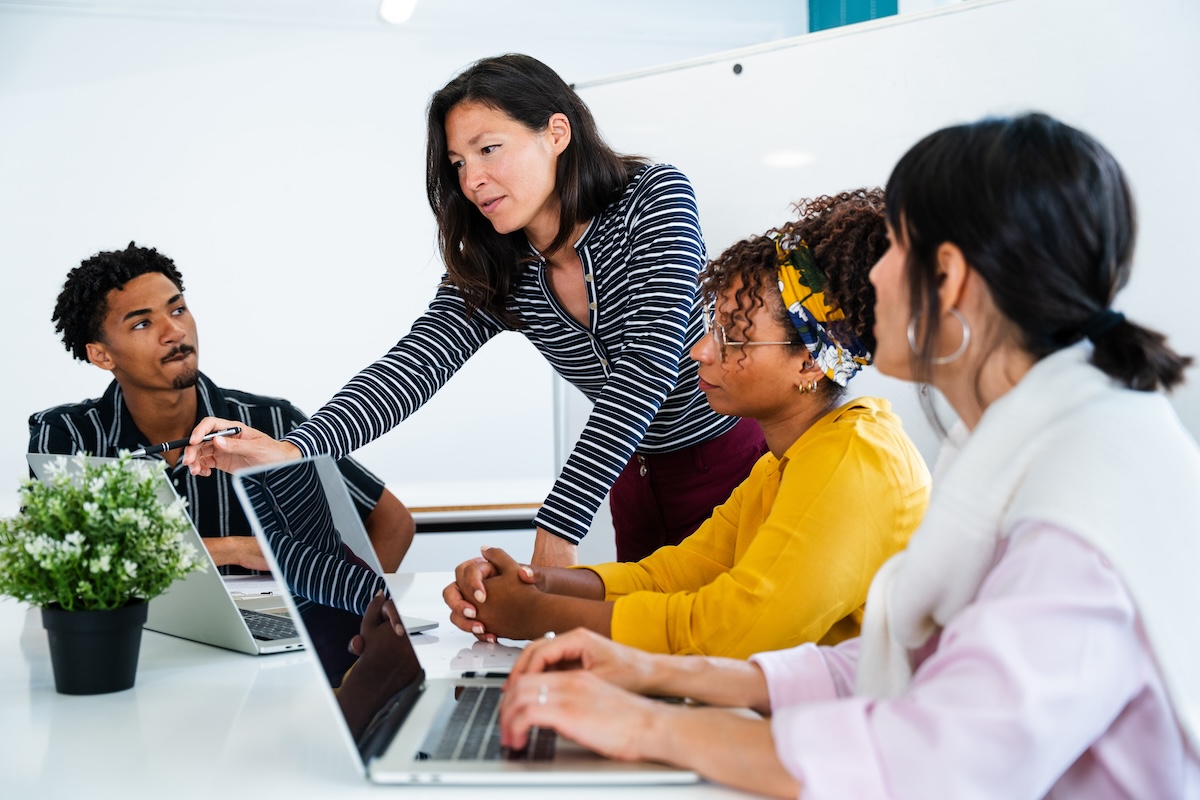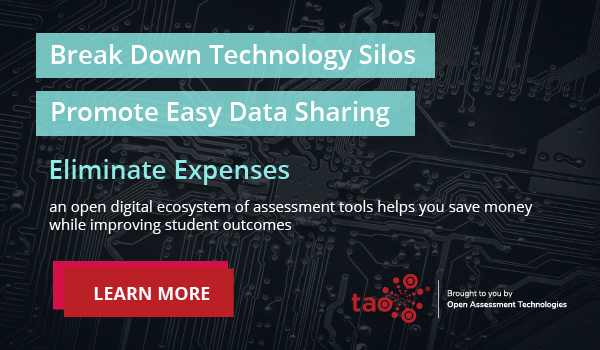Open educational resources (OERs) seem like the perfect solution to any assessment challenge. Free, advanced, and media-rich resources that your school can use and modify at will? What could be better?
However, if you’ve had any experience implementing OERs, you know that too often, you get what you pay for. While they may work for some learners, quality and accessibility issues are common. Moreover, many OER solutions don’t always readily deliver the data you need to verify that students are actually learning.
In this article, we’ll look at 5 open educational resource examples in more detail to help you find solutions that fit your needs.
Key Takeaways
- Choosing the right OER for your institution can save time and money while improving learning outcomes.
- Top OER examples include OpenCourseWare, OER Commons, Khan Academy, OpenStax, and MERLOT.
- While quality and accessibility vary both across and within these collections, they tend to maintain high standards.
- To make the most of OERs, pair them with open-source assessment software.
Evaluating Quality and Accessibility in OERs
OERs have the explicit support of UNESCO, and they’re becoming an interesting supplement to traditional EdTech solutions, pointing to a more open future. However, not every OER fulfills accessibility standards like the WCAG, which can be a challenge for institutions with a mandate to ensure equal access for all learners, including those with visual, auditory, motor, or cognitive disabilities.
Below, we look at 5 popular examples of open educational resources and break down their quality and accessibility scores.
1. MIT OpenCourseWare
The Massachusetts Institute of Technology, or MIT, is renowned as one of the world’s leading technical universities. It should come as no surprise, then, that its OER, MIT OpenCourseWare (OCW), is well regarded. The publication is essentially a freely available collection of material from thousands of MIT courses. Many OCW courses come with free video lectures, online textbooks, and lecture notes.
Of course, if you’re at an elementary school, MIT’s OCW won’t be of much use to you. But if you’re teaching advanced-level school courses or programs, OCW is a treasure trove of ideas, resources, and lectures.
While course quality varies a bit, each course is actually taught at MIT, so excellence is the norm. However, students with accessibility challenges could have a hard time making the most of OCW resources. Many courses have both video and audio content, but the majority do not.
If you’re interested in using OCW, head to their Educator page for guidance.
2. OER Commons
OER Commons was created by the Institute for the Study of Knowledge Management in Education (ISKME) in 2007. Since then, it’s become a leading source of OER resources. Designed as a digital public library and collaboration platform, it provides educators and administrators with both resources and the chance to collaborate with other teachers and education pros.
Thanks in part to its longevity, the OER Commons now contains over 50,000 OERs, including K–12 lesson plans, public domain textbooks, and even university courses. It’s to be expected that quality varies quite significantly across the library.
To help educators make the most of the commons, ISKME provides training programs, hubs, microsites, and integration services. It also provides accessibility features such as an Accessibility Checker, Accessibility Tags, and a collection of accessibility resources.
3. OpenStax
Rice University founded OpenStax in 2012 with the goal of sharing peer-reviewed digital textbooks and EdTech tools with high school and college instructors. The site claims to be the “world’s largest publisher of OERs. Examples include courses in math, business, history, and science, as well as assignment software.
OpenStax resources are used by over 7 million students from 153 countries. The organization aims to make textbooks more affordable for students, and according to economist Mark Perry, it has succeeded in doing so.
In keeping with OpenStax’s goals, the site has partnered with Level Access to enhance accessibility. Its websites meet the W3C-WAI Web Content Accessibility Guidelines (WCAG) 2.0, 2.1, and 2.2 at Level AA and Section 508 of the Rehabilitation Act.
4. Khan Academy
Khan Academy was born when Salman Khan started tutoring his cousin in math using Yahoo! Doodle Images. After other family members started following along, Khan put his content on YouTube. From there, he launched one of the world’s leading OER nonprofits.
Khan Academy’s courses range from K–12 math to advanced topics in economics and social studies. They’ve been translated into 36 languages, making it possible for people from all over the world to learn for free. If you want to get started with Khan Academy, check out the freely available Khan for Educators course.
Thanks to peer review, Khan Academy courses are generally high quality. As for accessibility, the platform offers users the ability to hide visually dependent content, reduce motion and animations, remove color from videos, and show captions. The organization uses the Web Content Accessibility Guidelines (WCAG) 2.1 Level AA as its baseline.
5. MERLOT
MERLOT’s history dates back to 1997. Since then, it’s grown into an international network of educators and institutions who have made over 100,000 learning resources publicly available. MERLOT resources include courses, activities, EdTech tools, immersive experiences, and assessments. About 90% of the resources on MERLOT are available cost-free.
The quality of MERLOT materials is generally high, thanks to over 20 editorial boards and peer reviewers. It also has an accessibility project that brings together experts from California State University, Open Education Consortium, and the National Federation of the Blind. However, the accessibility of MERLOT resources can vary significantly.
Choosing the Right OERs For Your Institution
When researching and recommending OER collections, keep the unique quality and accessibility needs of your organization in mind. In an assessment scenario, for example, you could choose to select open-source test questions that you could then host and deliver with an open-source assessment platform like TAO, which is designed to ensure complete accessibility for test-takers.
TAO is built on the Question and Test Interoperability (QTI) standard, so you can easily integrate standards-based content from 3rd-party sources and OERs into your assessment environment. That means you don’t have to bring on in-house IT staff to convert the assets to the appropriate format. Rather, if they are QTI-based, you can directly integrate them when building your test without specific technical knowledge.
Once the content has been imported, educators can then open those items in TAO’s interface and adapt them—adding accessibility features, grading criteria, text blocks, or media files to fit their learners’ needs. Moreover, they can also tag items with metadata (such as learning objectives, grade level, or subject area) so content is easy to search, organize, and align with standards.
By reducing technical headaches in this way, you can give your educators the freedom to use the materials that best fit their learners, without red tape.
Conclusion
When you choose the right open educational resources, your institution will gain more flexibility, equity, and long-term value for students. OpenCourseWare, OER Commons, OpenStax, Khan Academy, and MERLOT all do a great job providing high-quality, accessible resources.
If you’re looking for K–12 resources, OER Commons and Khan Academy are a sensible choice. For advanced high school, university, and professional learning courses, OpenCourseWare, OpenStax, and MERLOT can give you an edge.
To learn more about open educational standards, check out these helpful resources from TAO:
- Open Standards in Educational Assessment: The Key to Flexibility and Interoperability
- How To Leverage Data From Computer-Based Assessments
- Where Educators Can Find High-Quality Open Educational Resources
Get Started With OER on an Open Platform
If you’re exploring OER tools to cut costs and expand access, the next step is making sure your technology doesn’t lock you in. TAO is built on open standards, so you’re free to use and share resources—whether they’re open item banks, homegrown content, or licensed material—without being boxed into a single vendor’s ecosystem. That flexibility is what makes OER viable at scale. See how TAO’s open-source platform supports real interoperability and future-proofs your assessment strategy.
Schedule a demo today to see how TAO turns open standards into tangible benefits for your institution.

